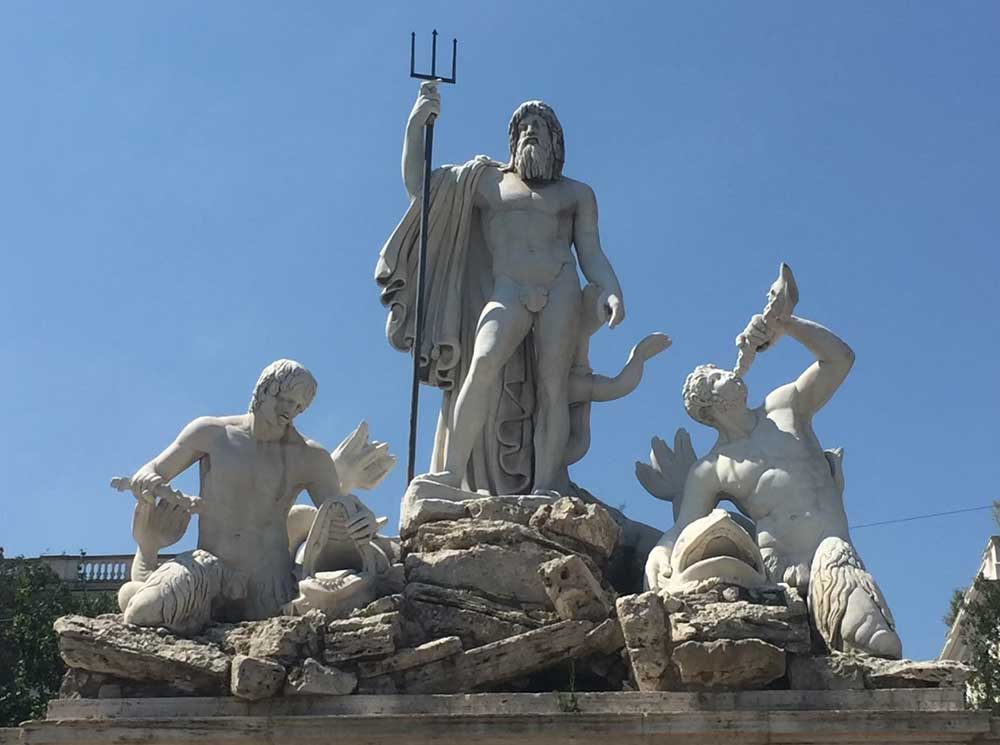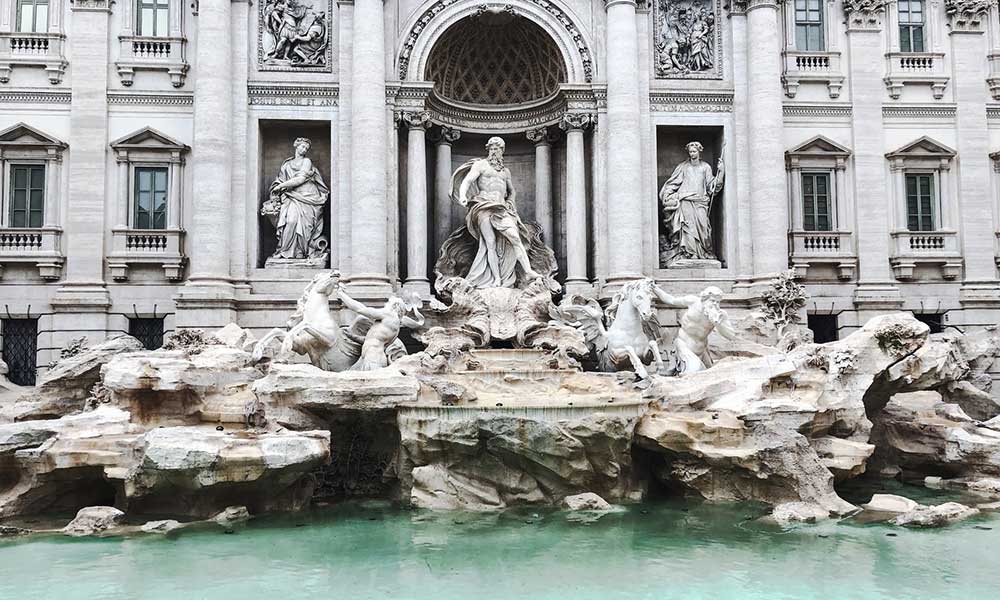The god of the sea is Poseidon in ancient Greek mythology and is also considered to be the god of earthquakes and horses. He is considered to be the god that invented horses. He known as “Neptune” in Roman mythology.
The winged Pegasus was the most famous horse Poseidon fathered. He’s also one of the original six Olympians.
He drew straws with his brothers to determine how the world would be divided and was given the sea when he drew the second shortest straw during the lottery.
He spent his time living in his underwater palace with his wife and son.
Similar to other types of gods, Poseidon possessed a lot of strength and had the unique ability to shapeshift.
He’s also known for moving at high speeds and possessing immortality and invulnerability.
He has the ability to control the different seas and everything they contain.
As Lord of the Sea, he could also control severe droughts and floods by using his trident.
When a specific region on land experienced droughts, they took this as a sign that Poseidon was not happy with them.
Fishermen and sailors often offered many types of items as sacrifices to Poseidon because they relied on the sea for their livelihood.
Poseidon is known to be extremely moody and short-tempered, and as one of the most greedy Olympian gods.
If he becomes insulted, he’s quick to seek revenge against his enemies and was known to get involved in conflicts with other gods.
When he was upset and angered, the earth would shake, and earthquakes would take place.
This prevented the Greek cities from being safe from his anger due to the destruction he would cause.
He had a conflict with a lot of figures, including the goddess Athena.
Poseidon was connected to dry land. Some of his main places of worship were located inland.
As the son of Cronus and Rhea, Poseidon’s father swallowed him with Hera, Hestia, Hades, and Demeter.
Who Are The Greek And Roman Gods Of The Sea?
There are many Greek and Roman gods of the sea, which include well-known figures like:
- Zeus,
- Hera,
- Poseidon,
- Cronus,
- Aphrodite,
- Hades,
- Hephaestus,
- Demeter,
- Apollo, and
- Athena
Additional gods include Artemis, Ares, Hermes, Dionysus, Persephone, Eros, Gaia, Hypnos, Rhea, Uranus, Nike, Eos, Pan, Selene, Helios, Heracles, and Odysseus.
Romans adopted many of the Greek gods and goddesses, many of which underwent name changes.
Who Is Poseidon’s Son?
Triton is Poseidon’s son in Greek mythology and was considered a demigod of the sea.
As a merman, he lived with his family in a golden underwater palace. He had the chest and arms of a man, but the bottom of his body was the tail of a fish.
He would blow into a twisted seashell to control the waters and create waves or make them calm.
Like his father, Poseidon, he also carried a trident in his hand.
He had a son named Pallas and was a father figure to Athena, a goddess.
He appeared in only a few mythological tales and ancient stories.
There are a total of 18 gods of the sea, and they were commanded by Poseidon and his queen, Amphitrite.
A lot of sea gods are present in different maritime scenes in Greco-Roman mosaics.
The gods of the sea include Amphritie, who Poseidon’s wife and initially fled from his advances.
Delphin, the dolphin god, convinced her to return to him to follow through with getting married to the sea god.
Aphrodite was the god of love, pleasure, and beauty and was known to be extremely beautiful.
She’s often depicted nude or with a winged holding.
As one of the 50 Nereides, Galatea is another sea god. She spent a lot of time in Sicily on the coast.
Her natural beauty attracted a lot of other gods, including Kyklops Polyphemos and Akis.
Galatea eventually turned Polyphemos into a stream when he crushed Akis due to his jealousy.
She’s often depicted in different types of art riding a sea monster.
Ikhthyokentauroi was a pair of sea gods that had upper bodies that made them look like men.
The lower portion of their body was similar to horses.
This pair of gods were brothers and had eyebrows that looked like lobster claws.
Leukothea had the reputation of coming to the aid of sailors that became distressed out at sea.
She was originally a mortal princess and was married to Athamas.
They both came under the wrath of Hera when they chose to take care of an infant god, Dionysos.
Nereides were fifty sea-nymph daughters of Nereus that dwelt with their elderly father at the bottom of the sea in a grotto.
The beautiful maidens were often depicted as riding on the back of dolphins.
Nereus is one of the most well-known gods of the sea and was a master shapeshifter.
He had a prophetic voice and often carried a wooden staff in hand.
He is most recognizable in artwork by the chiton he wore.
Oceanus was one of the oldest Titan gods and was capable of controlling different bodies of water.
He didn’t participate in the war against Zeus and the Olympian gods or the castration of his father.
If he wasn’t the favored son, he should be.
Palaemon was a younger sea god that was a child and was the son of Leukothea.
He was often riding a fish or dolphin in many paintings and mosaic artwork.
Phorkys was another sea god who had dominion over the deep regions of the sea.
He was married to Keto, who reigned over the largest creatures in the water.
Keto and Phorkys had children who were dangerous sea monsters.
Their children were responsible for creating the different rocks and reefs in the sea simply with their gaze.
Pontus was one of the oldest gods and embodied the sea and was born when the world was originally created.
He was the father of different sea creatures and fish, whom he created with Gaia, the earth.
Poseidon is one of the more well-known sea gods and had dominion over the sea.
His raging temper often triggered earthquakes on the land. He is also the god of droughts, horses, and floods.
Many ancient mosaic art pieces depict this god with a trident in his hand.

A statue of King Neptune, Rome, Italy. Neptune is the Roman version of the Greek’s Poseidon.
As a sea monster, Skylla terrorized different types of ships that sailed in the water and were known to cut off the heads of men as they sailed too close.
Her voice sounded similar to dogs barking and yelping.
In her mouth, she had three rows of sharp teeth. Some late classical writers say she was originally a gorgeous nymph until a witch turned her into a monster.
There’s also the belief that she was always a monster born into a family of monsters.
Sirens were three sea nymphs that were known to lure sailors with an alluring song, which always led the men to their death.
The nymphs were once handmaidens of Persephone, a goddess, but were given the bodies of birds by Persephone.
Tethys was a Titan goddess and was married to Oceanos and the daughter of Gaia.
She has often been equated with Thalassa and nourished the earth with her freshwater.
Thalassa was a primordial god that produced fish and other types of marine life in the water.
She was considered to have the literal body of the sea and is often depicted as a woman wearing seaweed.
As the leader of the 50 Nereides, Thetis was a sea goddess who had the ability to prophesy and was capable of birthing a son that was greater than his father.
She was ordered by Zeus to wed a mortal. She married Peleus and had a son, Akhilleus, who was considered to be a hero.
As a fish-tailed sea god, Triton was the son of Poseidon, who had the ability to create calming waters and make the waves go still in the ocean.
He carried a conch-shell trumpet, which helped him control the water.
Lir is known as the Celtic god of the sea in Irish mythology. His name reveals that he is considered a personification of the sea instead of a deity.
The “Book of Invasions” from the 12th century describes this sea god as being dissatisfied that he wasn’t selected to be Dé Danann, which caused him to avoid participating in world affairs.
He lived alone under a hill in County Armagh until he was finally lured back by Aobh.
Aobh offered one of his foster daughters to be Lir’s wife, and they had four children together. She died giving birth to their twins.
Aobh offered another one of his daughters to be his second wife as a replacement.
He then married her sister, Aoife, who was a witch and despised Lir’s children.
This caused her to turn them into swans, which was described in the book “The Tragic Fate of the Children of Lir.”







